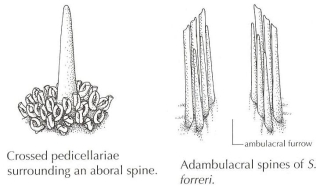Stylasterias forreri is a large slender-armed, black sea star with large aboral spines surrounded by prominent wreaths of pedicellariae. The common large form has white spines, grey wreaths of pedicellariae, and black skin and papulae with yellow tube feet on the lighter oral side. Other colour morphs, usually found on rock, are grayish-brown and, rarely, a straw colour. The five arms reach up to 33.5 cm in length and the arm-to-disc ratio is 11 to 16. On each arm long (4 to 5 mm) slender white spines occur in three to five longitudinal series. Each spine has a heavy wreath of crossed pedicellariae. Between the wreathed spines are groups of 8 to 10 papulae with an occasional large straight pedicellaria. On the side of the arm, the superomarginals bear a closely spaced, regular row of pointed spines surrounded by a smaller wreath of pedicellariae than the aboral spines. The inferomarginals have two scoop-shaped spines with a tuft of pedicellariae on the aboral side of each spine. The adambulacrals bear one thin furrow spine and another slightly larger flat spine on the oral surface. Small mouth plates, proximal to a short adoral carina of two plates, have two or three marginal spines and one sub oral.
Characteristics
Similar SpeciesStylasterias forreri might be confused with Lethasterias nanimensis or Orthasterias koehleri, but the living colours are quite distinctive. Otherwise, the details of the aboral pedicellariae should be examined.
